Chess Notes
Edward Winter
When contacting us by e-mail, correspondents are asked to include their name and full postal address and, when providing information, to quote exact book and magazine sources. The word ‘chess’ needs to appear in the subject-line or in the message itself.
| First column | << previous | Archives [178] | next >> | Current column |
11314. Emanuel Lasker and draughts/checkers
Some more games of draughts/checkers played by Emanuel Lasker, against Charles Welen and Charles Hefter, have been forwarded by Richard Forster (Zurich).
From the Inter Ocean (Chicago), 14 December 1902, page 58:

From page 15 of the 1 February 1903 edition of the same newspaper:


11315. Fred Reinfeld
Claims that Edward Young was a pseudonym for Fred Reinfeld were discussed, inconclusively, on page 327 of Kings, Commoners and Knaves and in C.N. 5014.
From page 158 of the new book mentioned in C.N. 11310, Fred Reinfeld. The Man Who Taught America Chess, with 282 Games by Alex Dunne:

Although, naturally enough, the general index has no entry for William Winter, it does refer to ‘Richard Cole’ (Richard Nevil Coles), ‘E. Sergeant’ (P.W. Sergeant), ‘Jack Spense’ (Spence) and ‘Rudolph Spielmann’ (Rudolf), errors which also occur in the body of the book.
A lamentable feature is some of the sourcing, or lack thereof. The references provided by Dunne include the following:
‘Chess Forums at Chess.com’ (page 47); ‘An Internet review by Mianfel states ...’ (page 56); ‘Wikipedia’ (page 94); ‘Chess Forums at Chess.com’ (page 131); ‘Chess Forums, Chess.com’ (page 142); ‘A review following the book’s Amazon advertisement read ...’ (page 160); ‘ChessManiac’ (page 168); ‘Arnold Denker in Chess Forums said of Reinfeld ... Chess.com’ (page 170); ‘ChessManiac’ (page 170); ‘The letter was published in ChessBase’ (page 173).
11316. Hereford, 1885

In this well-known picture from page 209 of the Illustrated London News, 29 August 1885 the caption has inverted Thorold and Mason’s names.
Gerard Killoran (Ilkley, England) draws attention to a photographic version at the Herefordshire History website. It is unclear to us what has happened to A.B. Skipworth:

A different group photograph taken during the tournament was auctioned in September 2018 and can currently still be viewed at the Invaluable.com website.
11317. Links to Cuban publications
Yandy Rojas Barrios (Cárdenas, Cuba) reports that Cuban publications available online include the Diario de la Marina and Bohemia.
11318. Caras y Caretas
Noting that the Argentinian weekly magazine Caras y Caretas is available via the digital collection of the Biblioteca Nacional de España, Olimpiu G. Urcan (Singapore) has forwarded these items:

25 June 1910
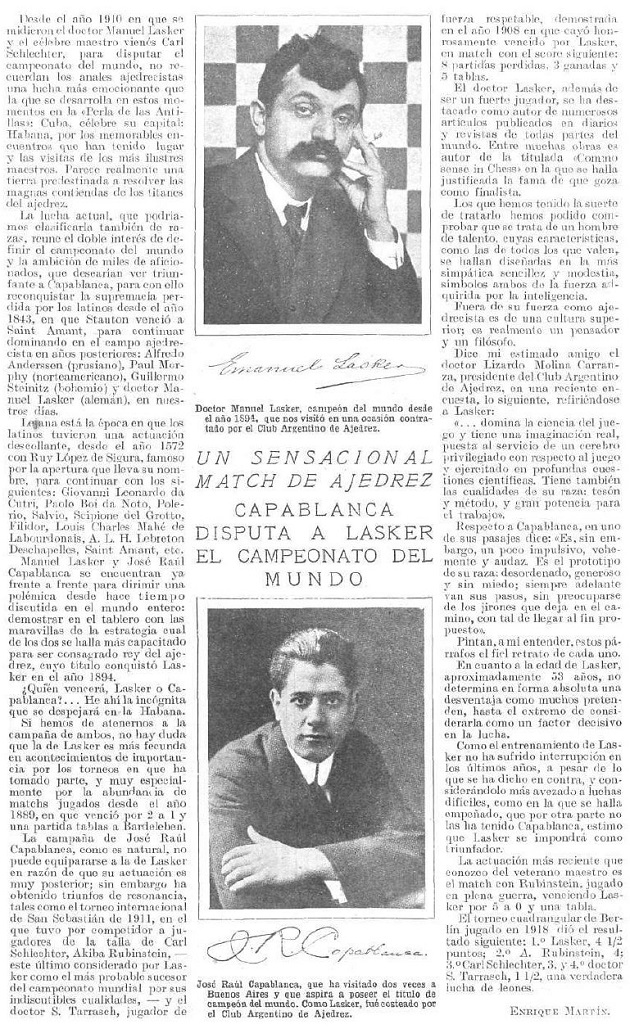
26 March 1921
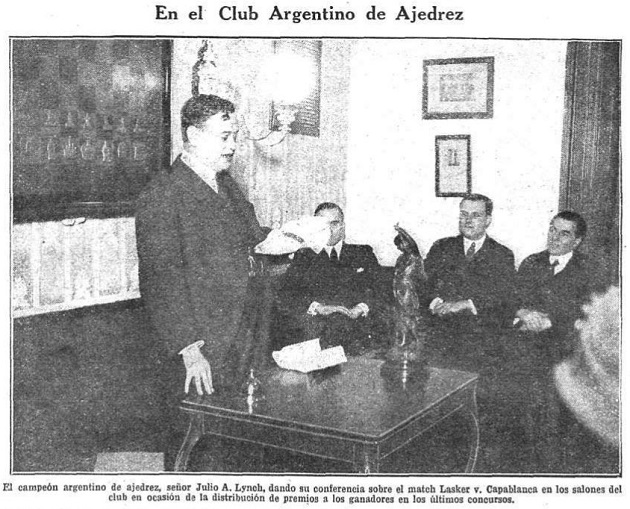
7 May 1921
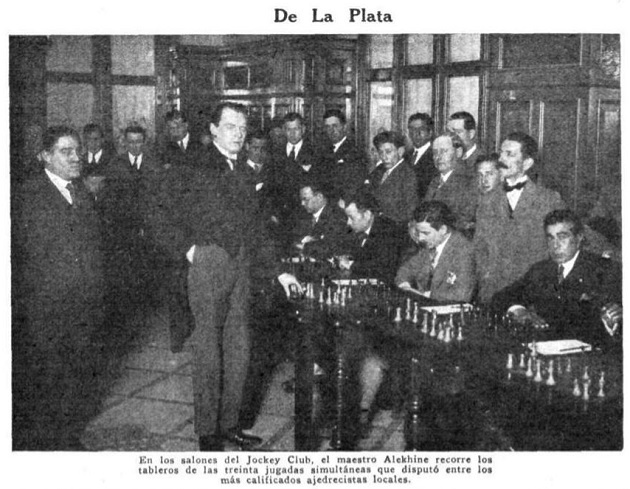
13 November 1926

16 April 1927

17 September 1927

17 September 1927

10 December 1927
Page numbers are not indicated in the material presented online by the Library. Although the interview with Capablanca conducted by Ernesto E. de la Fuente (17 September 1927) was hurried and contains evident factual errors (about his chess beginnings and the Cleveland simultaneous display), Capablanca’s remarks on Alekhine and on training/preparation/intuition are noteworthy.
11319. Staunton and Harrwitz
A number of items (see, for instance, Attacks on Howard Staunton) have quoted, sans parti pris, criticism of Staunton’s intellectual honesty.
An addition from pages 381-382 of Daniel Harrwitz’s British Chess Review, 1853:


Below is the relevant part of the Illustrated London News column referred to (5 November 1853, page 383):

From earlier in the same column a response by Staunton to ‘Pedagogus’ is notable:
‘You must not estimate a man’s intellectual power by his skill at chess. Some of the ablest men we have known play chess, in spite of great application, very indifferently; while many blockheads we have met with play very well.’
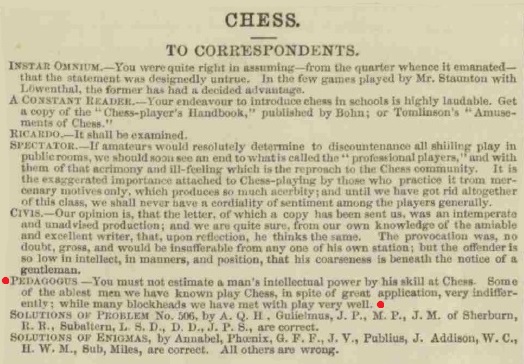
11320. Blindfold display by Carl Schlechter
From page 190 of the December 1898 Wiener Schachzeitung:

This photograph is on page 8 of Das interessante Blatt, 22 December 1898:
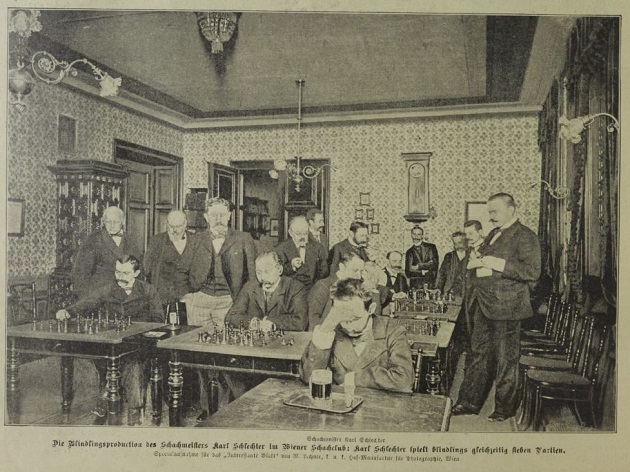
11321. John Wisker
An addition to Chess Grandmasters from the obituary of John Wisker on page 88 of La Stratégie, 15 March 1884:
‘Sans être un grand maître, ou du moins sanctionné tel, puisqu’il n’avait pris part à aucun tournoi international, M. Wisker était de première force; en 1870 il était champion de l’Angleterre et sa renommée serait devenue universelle s’il n’avait dû quitter la Métropole pour l’Australie.’
Pages 121-122 of the August 1872 Chess Player’s Chronicle praised Wisker (‘depth, soundness and brilliancy are all characteristics of his play’) when noting his victories in the British Chess Association’s Challenge Cup (‘England’s champion chessplayer’) in 1870 and 1872.

John Wisker
This photograph is from page 353 of the August 1893 Chess Monthly. The following page had a biographical feature which reported that after moving to Australia Wisker ‘pursued his literary occupation, contributing to the Fortnightly Review an article on “Troubles in the Pacific” which attracted so much attention that it gave rise to a debate in the House of Commons’.
In this and many other respects, the biographical feature bears a disconcertingly close resemblance to Wisker’s obituary on pages 134-135 of the April 1884 BCM.
11322. Morphy and checkers (C.N. 11294)
C.N. 11294 asked for information about this paragraph on page 48 of the American Chess Bulletin, February 1927:

Noting that the Draughts World ceased publication in 1913, the Cleveland Public Library has looked for the article in a 1926 or 1927 issue of the Draughts Review, but without success.
11323. Adolf Anderssen v Lionel Kieseritzky
Some more snippets regarding The Immortal Game:

Chess Words of Wisdom by Mike Henebry (Victorville, 2010), page 346

The World of Chess by Anthony Saidy and Norman Lessing (New York, 1974), page 86

Chess An Illustrated History by Raymond Keene (Oxford, 1990), page 48

Championship Chess and Checkers for All by Larry Evans and Tom Wiswell (New York, 1953), page 49
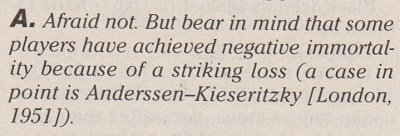
Chess Life, May 1996, page 15 (a reply in the ‘Evans on Chess’ column).
11324. Drawn endgame (C.N.s 3379 & 3516)
From page 68 of Chess Panorama by William Lombardy and David Daniels (Radnor, 1975):

C.N. 3379 (see page 20 of Chess Facts and Fables) asked whether confirmation of this story could be found in contemporary sources.
Olimpiu G. Urcan (Singapore) writes:
‘When the game was published on page 8 of the 18 July 1898 edition of the London Standard, a column edited by Leopold Hoffer, who was reporting from Vienna, only a basic observation was appended to the score:
Twenty-three years later, when writing about the Lasker v Capablanca world title match in Havana, Gyula Breyer recounted the Chigorin/Tarrasch episode on page 9 of the 27 March 1921 issue of Bécsi Magyar Újság. He described Chigorin’s draw offer and the act of removing the bishop from the board as facts.
What was Breyer’s source for this assertion and how reliable was it?’
For an English version of Breyer’s article, see pages 672-674 of Gyula Breyer. The Chess Revolutionary by Jimmy Adams (Alkmaar, 2017).
11325. Morphy letters
Two letters from pages 166-167 of Paul Morphy The Pride and Sorrow of Chess by David Lawson (New York, 1976):


Concerning the first letter, we add the frontispiece to the 15 August 1884 issue of La Stratégie:

The English and French do not fully correspond. For instance, the passage beginning ‘... mais j’en ai une à vous faire, qui ...’ is absent from the English version.
Frank Skoff’s ‘list of letters (plus some other items)’ in Lawson’s biography of Morphy was shown in C.N. 10294.
11326. Books about Capablanca
In C.N. 11311 a Cuban correspondent referred to ‘a Spanish version of Miguel A. Sánchez’s McFarland book, entitled Capablanca, leyenda y realidad (Havana, 2017 – although it did not appear until 2019)’.
The bare bibliographical details in catalogues and listings (including Books about Capablanca and Alekhine) are liable to seem confusing, and we therefore show some information from the book itself:

A 405-page paperback, it was published by Ediciones Unión, Havana, with 2017 on the imprint page but June 2018 at the very end of the book:


An explanatory note is on page 8 (with McFarland’s name misspelt):

The typographical rigour of the McFarland edition has gone, as have large sections of the text and most of the indexing.
Regarding the first two works on Capablanca by M.A. Sánchez, see C.N. 9434.
11327. How to learn chess
The conclusion of Tarrasch’s Vorwort (Preface) to Das Schachspiel (Berlin, 1931), pages 3-4:


From the English translation, The Game of Chess (London, 1935), pages x-xi:


Attention is drawn to Tarrasch’s advice to the beginner in the second and third sentences:
‘His very understandable desire to play a game as soon as possible he must suppress. To play games while still in the beginner’s stage is the surest way to become an unskilful player.’
Leaving aside the validity or otherwise of that advice, we wonder whether any other prominent chess teachers have written similarly.
11328. Goulding Brown
A game published on page 606 of Britannia, 12 April 1929, in a column edited by T.C. Evans:

1 d4 Nf6 2 c4 e6 3 Nc3 d5 4 Bg5 Be7 5 e3 O-O 6 Nf3 c6 7 Bxf6 Bxf6 8 h4 dxc4 9 Bxc4 b5 10 Bd3

10...h6 11 g4 g6 12 g5 hxg5 13 hxg5 Bxg5 14 Ne5 Kg7 15 Qf3 Nd7 16 O-O-O Bb7 17 Nxf7 Qe7 18 Rh7+ Kg8 19 Rdh1 Nf6 20 Nh6+ Resigns.
After Sifton’s move 10...h6 computers consider that the game is essentially already over.
Given the reference to ‘R. Goulding Brown’ in the heading, reassurance is sought that White was indeed Bertram Goulding Brown (1881-1965). Two games played by him in Cambridge the same year against P.S. Milner-Barry are on pages 268-270 of the July 1929 BCM.
An extract from Milner-Barry’s obituary of Goulding Brown on pages 344-345 of the December 1965 BCM:

Goulding Brown’s defence of Staunton appeared at the end of a wide-ranging article about P.W. Sergeant’s first Morphy monograph on pages 191-194 of the June 1916 BCM:
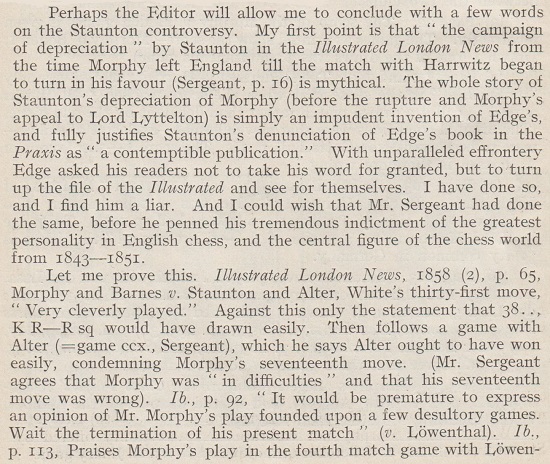


On pages 194-195 Sergeant responded to various points in the remainder of Goulding Brown’s article, ‘leaving a re-examination of the Morphy v Staunton controversy for some later occasion’. As shown in Edge, Morphy and Staunton, Frank Skoff was highly critical of Goulding Brown. See too page 153 and pages 255-257 of Paul Morphy The Pride and Sorrow of Chess by David Lawson (New York, 1976).
The warm, page-long obituary of Goulding Brown in the BCM stands in contrast to how his demise was treated by CHESS (end-October 1965 issue, page 41):

11329. Staunton and Harrwitz (C.N. 11319)
From John Townsend (Wokingham, England):
‘The 1853 British Chess Review article reproduced in C.N. 11319 contains expressions such as “egregious falsehoods”, “ridiculous absurdities” and “rubbish”, all directed at Howard Staunton. One might expect that such truculent language would be accompanied by suitable substantiation, yet in the few examples discussed only a small amount of evidence was proffered, and it looks far from convincing.
Staunton is accused of a “gross falsehood” regarding his remark that Harrwitz intended “a love match” against Löwenthal. However, that Harrwitz did say something similar was later affirmed by Charles Tomlinson, a scientific writer and lecturer whose recollection of the controversy appeared on pages 50-51 of the BCM, February 1891, in an article about Simpson’s Divan:
“Harrwitz was so elated at having won the first two games that he declared in my presence that Löwenthal should not win a single game.”
Later Tomlinson witnessed a confrontation in Spring Gardens when Harrwitz denied the boast, whereupon both Staunton and Tomlinson were silent:
“Staunton simply smiled, and said nothing. Of course I was equally silent, from a reluctance to get into hot water with the Divan party.”
Tomlinson’s account implies that he could have rebutted Harrwitz’s accusation.
The accusation “slink his challenge” is used in connection with the abortive negotiations in 1853 for a Staunton-Harrwitz match, but that seems a biased summary of what took place. In an address to the Northern and Midland Counties Chess Association at its Manchester meeting in 1853 (see the Chess Player’s Chronicle, 1854, pages 187-189), Staunton explained at some length his reluctance to accept Harrwitz’s challenge, observing, in particular, that he had previously beaten him in a match and that the opponent whom he was really seeking was Adolf Anderssen. Nevertheless, negotiations did eventually get underway, but later broke down, after which a letter from Edgar Sheppard, Staunton’s second, which was published on page 61 of the Illustrated London News, 21 January 1854 gave the impression that Harrwitz’s side had defaulted and forfeited the £25 deposit “by the articles of agreement”.
Staunton’s attitude towards playing for money appears to have changed with time, and he is criticized for that. Nonetheless, in the case of an important match a worthwhile stake was customary, and it is arguable that he was justified in seeking one for a match with Harrwitz in which he had little to prove, having previously defeated him decisively.
The article supports Löwenthal’s side of the argument over the disputed Staunton v Löwenthal score but, in the absence of any evidence to explain the reasoning, is the comment really worth anything?
The final sentence contains a mysterious threat regarding “the existence of certain letters”, presumably containing some compromising information about Staunton. However, the letters have not so far been “unpleasantly forthcoming”, despite the passage of 166 years. Without them the remark seems no better than tittle-tattle.
The editor of the British Chess Review was Daniel Harrwitz, but was he solely responsible for this article? It is questionable whether someone whose native tongue was not English could have produced the article without help. Tim Harding discussed the involvement of Samuel Standidge Boden with the British Chess Review on pages 130-132 of his book British Chess Literature to 1914 (Jefferson, 2018).’
11330. The Club Argentino de Ajedrez
In C.N.s 11219 and 11278 Eduardo Bauzá Mercére (New York, NY, USA) presented a number of photographs taken by him at the Club Argentino de Ajedrez during visits to Buenos Aires earlier this year. In addition, he put us in contact with Mr Carlos León Cranbourne (Buenos Aires), who has now sent us many further pictures.
The present item focuses on Fischer, and, in particular, his 1971 match in Buenos Aires against Petrosian:






The board in the fourth picture shows the conclusion of the final game of the 1972 Spassky v Fischer match.
11331. Letters from Jacques Mieses to D.J. Morgan
Professor Lord Morgan (Oxford, England) has forwarded us copies of three letters sent to his father, D.J. Morgan, by Jacques Mieses:



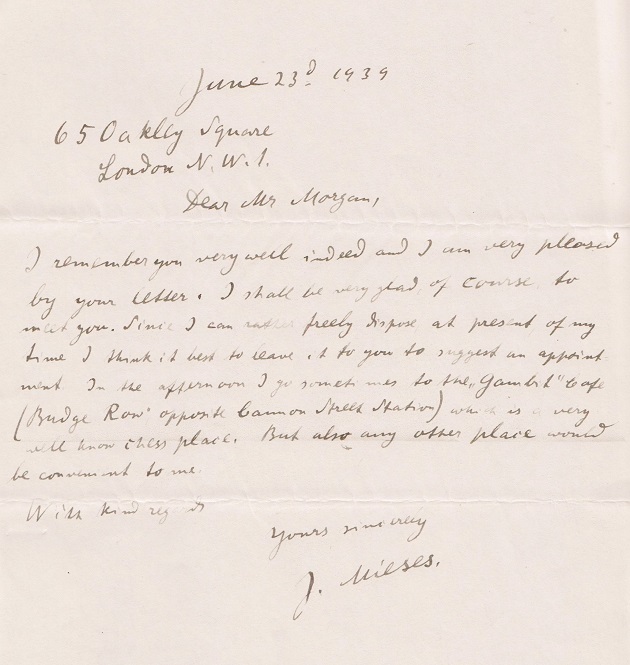
11332. Filiberto Terrazas v Fidel Castro
C.N. 1180 (see too C.N. 4049 and Fidel Castro and Chess) gave this game won by the Cuban leader in Havana in 1966:
1 e4 e5 2 f4 exf4 3 Nf3 Bd6 4 d4 h6 5 e5 Bb4+ 6 c3 Ba5 7 Bxf4 g5 8 Bg3 Qe7 9 Be2 d6 10 exd6 cxd6 11 Qa4+ Nc6 12 d5 Bd8 13 dxc6 b5 14 Qxb5 a6 15 Qa4 g4 16 c7+ Bd7

17 c8(Q) Rxc8 18 Qd4 gxf3 19 Qxh8 Qxe2 mate.
Luke McCullough (Mitchell, SD, USA) asks whether White’s 17th move was really c8(Q), and not cxd8(Q)+.
Firstly, we confirm that the improbable-looking 17 c8(Q) was given, although with a check sign, in our source, which was the November 1966 issue of the Cuban magazine Jaque Mate. Below is the full feature, which was by Terrazas himself:

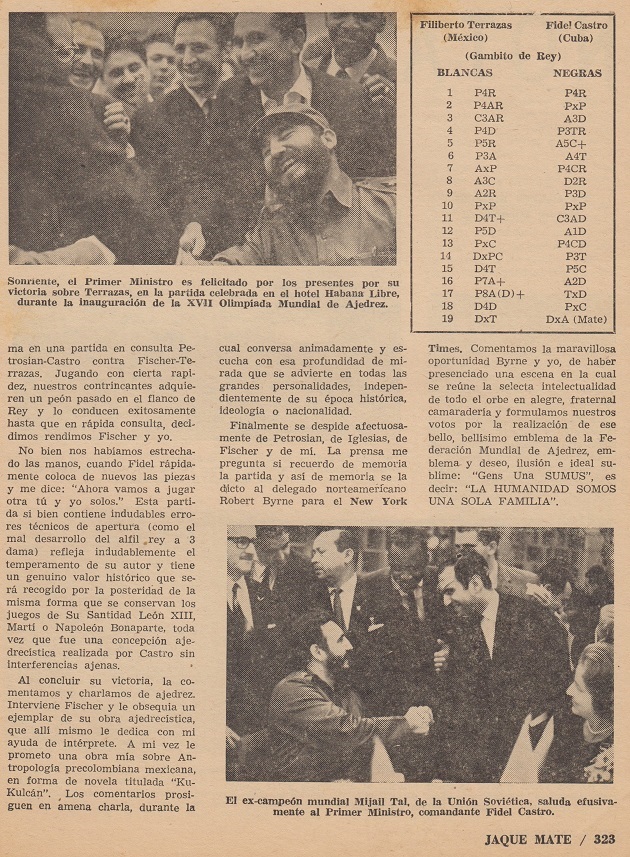

When the text by Terrazas was reproduced on pages 164-165 of El ajedrez en Cuba by José Luis Barreras Meriño (Havana, 2002), the moves were given as 17 cxd8(Q)+ Rxd8. That version is in a number of databases.
El ajedrez en Cuba (pages 165-166) had a second game played by Fidel Castro, as Black against Joaquín Camarera/Camarena:
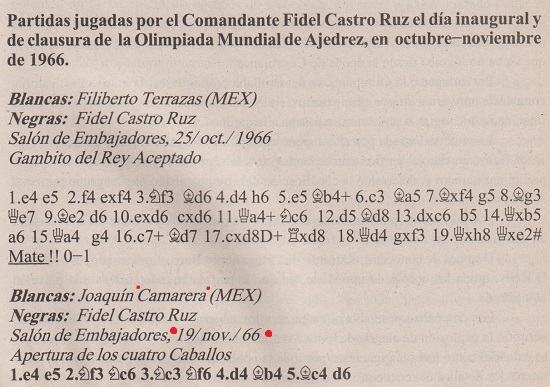
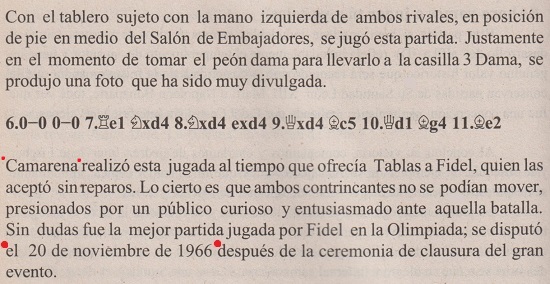
1 e4 e5 2 Nf3 Nc6 3 Nc3 Nf6 4 d4 Bb4 5 Bc4 d6 6 O-O O-O 7 Re1 Nxd4 8 Nxd4 exd4 9 Qxd4 Bc5 10 Qd1 Bg4 11 Be2 Drawn.
The first photograph in the Jaque Mate article is relevant to the discussion about Terrazas in Mysteries at Sabadell, 1945.
11333. Lasker v Janowsky matches

David Prabitz (Graz, Austria) draws attention to the listing, strikingly inaccurate, of Lasker v Janowsky matches on page xviii of From Steinitz to Fischer by Max Euwe (Belgrade, 1976):

It must be wondered how much involvement Euwe had in a work which states, for instance, that Capablanca brought out a book entitled The Beginners’ Handbook in 1932 (page xx) and which has this, regarding chess in 1927, on page xxiii:

The imprint page:

11334. Relationships (C.N. 4960)
C.N. 4960 mentioned briefly a tribute by W.H. Watts to J. Schumer on pages 109-110 of the March 1933 BCM, and the present item begins by showing the full article:
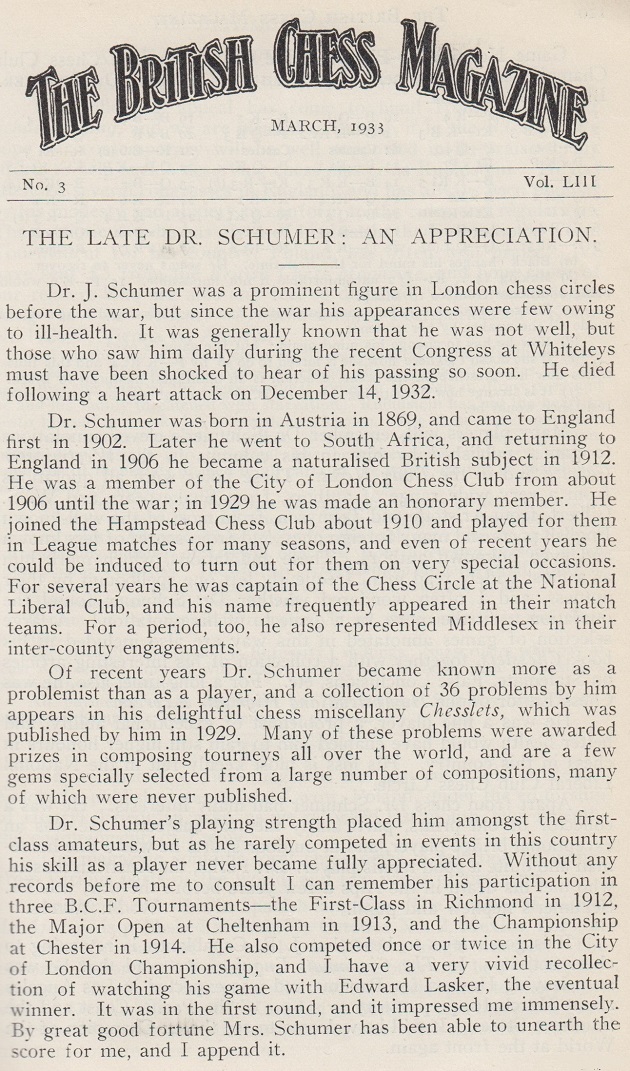

Regarding the final sentence, C.N. 4960 incorrectly attributed to Watts a claim that Schumer was a nephew of Perlis, instead of the opposite, and we are grateful to Michael Lorenz (Vienna) not only for correcting that point but also for providing detailed family information:
‘Dr Julius Perlis was a nephew of Dr Jakob Schumer. Klara Schumer was born on 14 February 1858, the daughter of the major landowner Isak Schumer (1838-1911) and his wife Therese, née Ostersetzer (1839-1922). Klara Schumer was an elder sister of Jakob Schumer, who was born around 1869 in Kamianka-Buzka (today in Ukraine, formerly Kamianka Strumilova in Galicia). Klara Schumer’s first husband, David Perlis from Bialystok (then Russia), died in 1881. On 29 June 1886, in Brody, Klara Perlis, née Schumer married the lawyer Dr Ezechiel (Eduard) Friedmann (1850-1919), with whom she had two more children: Margarethe (born in 1887, the first wife of the prominent silent film actor Dr Arnold Cohn-Czempin), and Emma (1887-91). The other two children listed in Dr Friedmann’s death notice were Wilhelm Friedmann (1884-1942, a renowned Romanicist), a son from Friedmann’s first marriage, and the stepdaughter Helene Eigermann, née Perlis (Julius Perlis’s sister, born in 1881 and murdered in 1942 in Maly Trostinec). Jakob and Klara Schumer’s father Isak Schumer died on 14 December 1911. His death notice, which was published on page 29 of the Neue Freie Presse, 16 December 1911, lists his six children, with Klara Friedmann and Dr Jakob Schumer among them. Tillie (Mathilde) Schumer, née Myers, was Jakob Schumer’s wife.
The death notice of Dr Julius Perlis (Der Morgen. Wiener Montagblatt, 15 September 1913, page 5) shows Klara and Dr Ezechiel Friedmann as the grieving parents:
Julius Perlis’s stepfather Dr Ezechiel Friedmann died on 20 February 1919. In his death notice (Neue Freie Presse, 25 February 1919, page 12) his widow was identified as “Clara Friedmann, geb. Schumer”:
The three children are discussed above. Friedmann’s son-in-law Leonhard Eigermann (1872-1931) was a bank official from Czernowitz who, on 28 February 1905, had married Helene Perlis. Their only son, Kurt Eigermann (born in 1906), a nephew of Dr Julius Perlis, was killed in the Holocaust.
Julius Perlis’s mother, Klara Friedmann, died on 10 October 1921 in Mauer bei Wien. She was survived by two children, Helene Eigermann and Margarethe Cohn-Czempin. The mother of Dr Jakob Schumer and of Klara Friedmann, Therese Schumer, died on 7 February 1922. In her death notice (Neue Freie Presse, 11 February 1922, page 16) Jakob Schumer was mentioned under his nickname “Kuba” (his second Jewish forename was Schulim):
Since Isak Schumer’s wife and Ezechiel Friedmann’s first wife Regina (1860-84) both came from an Ostersetzer family, it seems likely that there was a second relationship by marriage between the Schumer and the Friedmann families.’
11335. A composition by Keres

Mate in two
This composition by Paul Keres has been sent to us by Michael McDowell (Westcliff-on-sea, England), who writes:
‘The source is usually given as First Prize, Schackvärlden, 1934, but in his collection of 110 of Keres’ compositions Paul Keres Der Komponist The Composer (Vienna, 1999) Alexander Hildebrand indicates Third Prize, Postimees, 1942. His Preface (page 3) states: “the most special thanks are due to the composer’s wife, Mrs Maria Keres, whose willingness to make his collection of problems available has made this book possible.”
Can the source details of this two-mover by Keres be clarified? It combines an idea known to problemists as the Java theme (two white pieces guard a flight square (b4); the black defence closes one line, and White must be careful not to close the other) with unpins and a Grimshaw (mutual interference between rook and bishop) on e4.’
11336. Capablanca and Gedroiz (C.N.s 10196 & 10201)
Mikhail Sokolov and Yuri Kireev (Moscow) have forwarded some pages from Russian sources. In their references below, publication dates are in the old style, whereas the dates of events are given in both the old style and the new style:
- A feature on Capablanca in St Petersburg in Шахматный Вестник (Shakhmatny Vestnik), 15 December 1913, which mentions, on page 377, that in a simultaneous exhibition (+26 –2 =3) on 6/19 December 1913 one of the draws was secured by Prince Gedroiz (Gedroits):


- An article by Yuly Sosnitsky on page 3 of Вечернее Время (Vechernee Vremiya), 7 December 1913 about the same session:

Larger version of the photograph
- Page 999 of Нива (Niva), issue 50/1913, concerning a simultaneous display by Capablanca (+24 –3 =3) on 24 November/7 December 1913. Gedroiz did not play but is visible on the far left of the photograph:

Regarding photographs taken on this occasion, and a link to the Gallica website, see Capablanca’s Simultaneous Displays.
11337. Capablanca speaking on his 50th birthday
Olimpiu G. Urcan (Singapore) informs us that he has acquired from the Netherlands Institute for Sound and Vision the right to post on his Patreon webpage a brief audio file of Capablanca speaking in English during the AVRO tournament, on the occasion of his 50th birthday (19 November 1938).
11338. Yates and Schlechter
A photograph of F.D. Yates and C. Schlechter at Hamburg, 1910 has been supplied by Jan Kalendovský (Brno, Czech Republic), courtesy of Zdenĕk Závodný:

Source: Deutsche Frauen- und Modezeitung, 22/1910, page 12.
11339. Alekhine’s vase (C.N.s 3697 & 9924)
Another photograph of Alekhine with his vase was published on page 12 of Tidskrift för Schack, January 1934:

Acknowledgement for the above scan: the Cleveland Public Library.
The mirror image presented by the Swedish magazine is
amended below:

The smaller picture ...

... may be compared with a photograph which we have given in Sultan Khan from page 5 of the American Chess Bulletin, January 1932:

| First column | << previous | Archives [178] | next >> | Current column |
Copyright: Edward Winter. All rights reserved.





